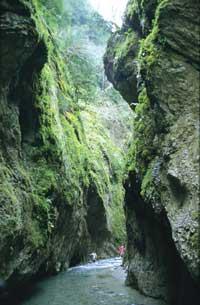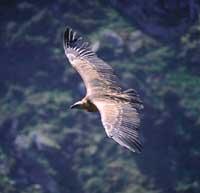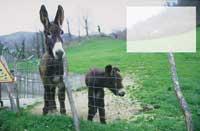New fans: April
Winter till late

Although it usually rains, the weather in April can vary a lot. When the environment helps, flowers of all colors and smells are born and the trees begin to dress with leaves. Mosquitoes, butterflies and many other bugs that had not been seen long ago will appear overnight. Anyway, if after a good run enters the winter storm… then you would eat! In fact, the late snow storm causes a lot of damage to living things that have just been launched, and it knows perfectly during the months of April and May. Ice, for example, causes the planted tree not to die, but as the renewal of the leaf takes a long time, the growth of that year is greatly reduced. In addition to the leaves, trees can lose flowers and fruits. Like plants, the winter environment of these times does not benefit animals, and the weakest move badly.
Most amphibians in reproduction
Krak, Krak (tree frogs),{\}...{\} (flute song from txantxikua). Krrroarrr, krrroarrr (water frogs). Although it is easy to understand that bird taps can attract the reproductive person, the corrugated frogs and toads seem less appropriate. But it is because we are not able to recognize the charm of these songs. This song that seems to us a stir is precisely the one that serves to attract the females of these species. In fact, in many amphibians sexual selection is channeled through chanting, which allows to easily understand the blind hobby of males to chanting.
Bird festival

At this point many birds have built the nest and there are plenty of birds that are spawning. However, until all eggs have been laid, avifauna will not begin to drown. In the case of amilotxa, for example, it will begin to incubate every 10 days after putting an egg to the last, so that all the offspring are the same age. However, many owls begin to incubate as soon as the first egg is put, so they usually have chickens of different ages. But this is another proper planning system. Thus, when they cannot find enough food for everyone, younger chicks die and avoid unnecessary expenses.
Below is the duration of bird incubation: from blackbird and txantxangorri 12 days, from txepetxa 14, from white owl 30 days and from griffon vulture 52 days.
Direct flights

Although it has been a few days since we discovered the swallows, at the end of this month the sorbells will begin to arrive. They are shaped like swallows but have longer wings, in the form of seams. They are very dark and fly, unique. From Africa they have had to travel the Honuntza road with an average speed of 70-100 kilometers per hour. The very short legs show us that they are not good walkers. Not bad! And it is that, as they fly alone, the sorbelous will not take any step throughout life. They rest to drown, to feed the young and for more, and in the rest, they fly a little through the sky. We can fly and copulate.
What happened to the deer?

Those who live in Pamplona know perfectly the deer of the Taconera and know that throughout this month branches fall to their people every year. As cows, sheep or goats do not lose horns, for many people this loss of horns can surprise. However, deer and, in general, cervids have branches with a solid bone structure that, due to hormonal change, are discarded and restored annually. As new branches begin to develop, wrapped in velvet, but when the heat arrives, they lose this leather cover and acquire its elegant appearance. In addition, although many people think otherwise, they do not develop a new tip every year. Branches depend on age and especially the time, so it depends on their size, diet, geographic region, population density, genetic characteristics and health status.
New families

In the fox hole there are four naughty fox puppies. They've been a few days old and are already approaching the threshold of the hole to see if their parents know the tip of the end. However, as soon as these approach, there are usually enough scandals. Like all other offspring, fox puppies starve and compete to catch their mother's most fertile queen. The mother, however, is concerned about the fact that in the morning she has noticed people around the hole, and today she is about to move her young to the hiding place of the forest around them.
Like the fox, most mammals are giving birth. The wild cat has had 5 young, one deer, four grapefruits, 9 jackets and three hares. For his part, Erbinude knows a wonderful male who will not let him escape. The birth, the grazing of the offspring and the other tasks related to reproduction, due to their high demand for energy, demand the mass hunting of animals. This is why it is time to see these terrible mammals more easily.
Larun pottokas have stopped

Unfortunately, the pottokas do not look as much as they wanted. Mixed with other equine races, this breed has suffered a strong setback until the last few years, since no measures have been taken to curb this trend. Today, among other things, in the Baztan and in many counties of the North you can see the pottokas and, lately, they have been included in some natural spaces. Larun, or the high of Otsondo, can be exceptional places to see pottokas with puppies in April.
Coming out of hibernation

Tonight they have gone through the beech trees of Urbasa. Thin and half-drawn, hunger soared. Considering that since November they had not left the hole, of course, it was no wonder that they were in that situation. During sleep they have become very thin and now weigh half of what we saw lately.
In the Pyrenees, the marmot and bear have just come out of the hole. Using the same strategy of the sargos, hibernation has been able to cope with all the snowfalls, frosts and winter rains, and we want to start them again with the increase of temperatures.





